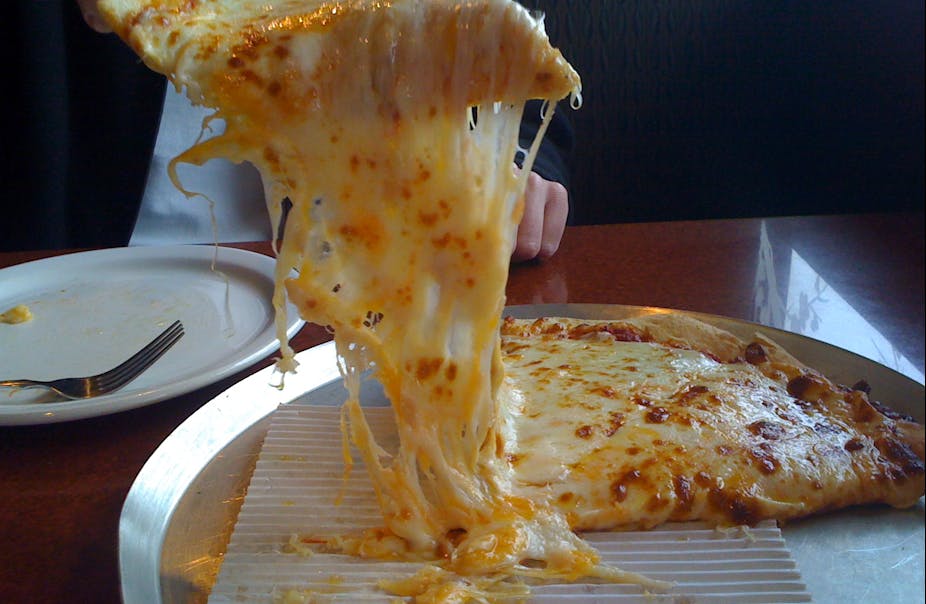The US Department of Agriculture (USDA) recently released a report on the role of pizza in American diets. Researcher Donna Rhodes and colleagues in USDA’s agricultural research department found that an astonishing 13% of the US population consumed pizza on any given day, based on the most recent years of the ongoing National Health and Nutrition Examination Survey.
For this large population – more than one in eight Americans – who consumed pizza in a particular day, the researchers found:
- Pizza accounted for 25% of children’s and 29% of adults’ daily food energy intake. More than a quarter of all calorie intake was pizza.
- Pizza accounted for 33% of children’s and 39% of adults’ daily saturated fat intake. Compared with foods in general, pizza is much heavier in saturated fat.
- Pizza accounted for 33% of children’s and 38% of adults’ sodium intake. Compared with foods in general, pizza is much heavier in sodium.
But in recent years, the USDA’s dairy checkoff programme has spent many millions of dollars increasing pizza consumption among US children and adults.
A checkoff programme is a semi-governmental programme that helps producers market an agricultural product. Using the federal government’s taxation powers, the checkoff programme collects a mandatory assessment (equivalent to a tax) of 15 cents on every hundredweight of milk that producers sell for use as fluid milk or dairy products. The money is then used to support marketing and promotion activities that encourage dairy consumption.
According to the most recent annual USDA report to congress, the total mandatory assessment in 2011 was US$104m for fluid milk and US$98m for other dairy products.
These expenditures are many times greater than federal spending on promoting fruits and vegetables, whole grains, or any of the other foods that the government’s dietary guidelines recommend increasing consumption of.
Each semi-governmental checkoff programme is managed by a board of producers appointed by the secretary of agriculture, and all expenditures are approved by USDA’s Agricultural Marketing Service (AMS). Much of the actual activity is carried out by Dairy Management Inc (DMI), a dairy industry organisation.
The checkoff programme goal is to provide increased economic demand for dairy producers. The USDA report also found the economic payoff to producers is greater for cheese marketing efforts than for fluid milk marketing efforts. The report concluded:
- For every US$1 the checkoff program spends on increasing demand for fluid milk, farmers get US$3.95 in increased revenue.
- For every US$1 the checkoff program spends on increasing demand for cheese, farmers get US$4.43 in increased revenue.
That differential payoff is unsurprising. During the recent years of checkoff programme operation, the USDA report charted the following trend in fluid milk consumption.

Meanwhile, the report charted the following trend in cheese consumption.

Pizza accounts for a large fraction of the increased cheese consumption, so the report emphasised the value for producers of partnering with fast-food restaurant chains, especially Domino’s Pizza. It said:
On average, expenditures on marketing and cheese promotion were US$12m during the period. Owing to partnerships with the pizza industry, notably Domino’s Pizza, expenditures on cheese increased from the fourth quarter of 2008 to the end of 2011.
DMI spent over US$35m over three years in partnership activities with Domino’s. The Domino’s relationship accounted for nearly three-quarters of DMI’s overall promotion expenditures in the cheese category over the 2009 to 2011 period.
And according to the report to congress, Patrick Doyle, president and CEO of Domino’s Pizza, explained why the support from the federal government’s dairy checkoff programme was so beneficial to the company:
DMI support has allowed us to focus some advertising dollars on areas we would not have considered otherwise. The Wisconsin 6 Cheese pizza has twice the cheese of a regular pizza, but we had neither developed nor advertised such a product. DMI helped fund the research and media to launch this product.
The report to congress argued that the USDA-supported dairy checkoff programme’s pizza partnerships increased cheese consumption.
The promotional activities with Domino’s included new product lines, use of more cheese than had been provided on similar items in the Domino’s chain before the partnership, and the introduction of specialty cheeses into the company’s recipes. In short, the assistance of dairy dollars was instrumental in positively affecting the pizza category, a category that is very important to the dairy industry.
Every dairy checkoff partnership must be approved by USDA. Every marketing message has official legal standing as “government speech” (because, otherwise, courts would see the mandatory assessment as a misuse of the federal government’s taxation powers). The checkoff partnerships undermine USDA’s standing as a credible voice in promoting dietary guidance for Americans, and they must be a terrible embarrassment for the many people at USDA who seek to promote healthy eating.
Many Americans find pizza to be an enjoyable treat, but, from a nutritional perspective, it is a dreadful choice of major food staple. It is understandable that food companies may promote pizza with their own money, but it is a travesty that the federal government should contribute so heavily to this effort, while neglecting other important nutrition goals.
A version of this article first appeared on Parke Wilde’s US Food Policy blog.

